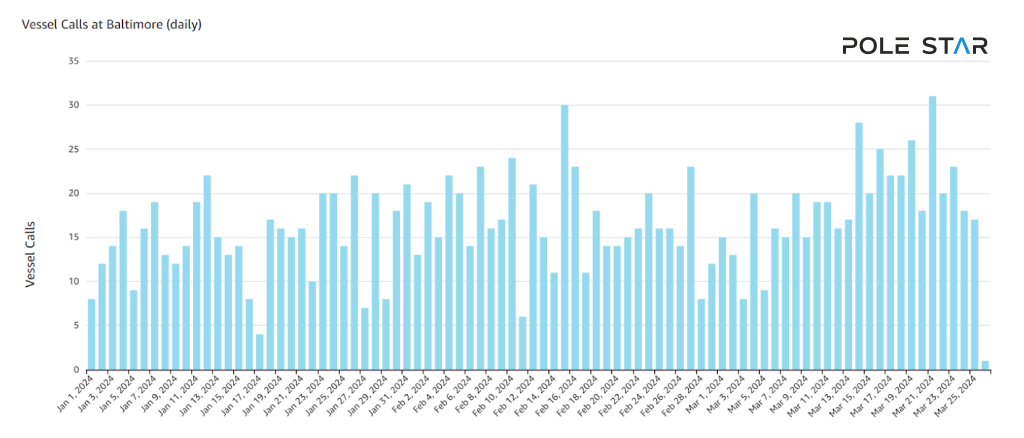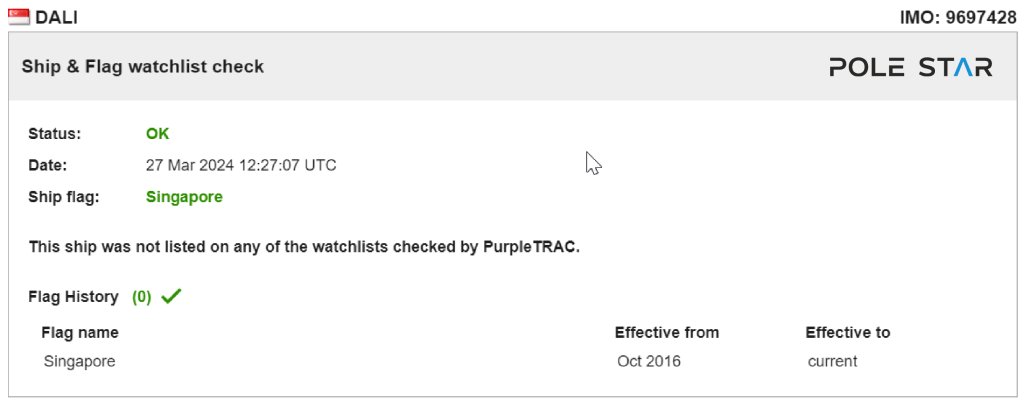
From Crisis to Contingency: Evaluating the Effects of Baltimore’s Bridge Collapse on Maritime Trade
Around 01:28am on Tuesday, March 27th, the Singapore-flagged vessel – DALI – collided with Baltimore’s iconic Francis Scott Key Bridge, causing its collapse into the Patapsco River. This tragic crisis has reverberated through people, society, and maritime trade. Captain Steve Bomgardner, Vice President of Shipping & Offshore at Pole Star Global reviews the fallout from this incident. Bomgardner explains the impact on import and export trade through the Port of Baltimore, and assesses the vessel traffic in the area (commercial and non-commercial).
Understanding the incident – a timeline of events
At the time of the incident, the DALI transported 4,699 twenty-foot equivalent units of cargo from East Asia to the US East Coast via the Panama Canal. The ship arrived at Baltimore’s Seagirt Marine Terminal on Tuesday, March 24th, following a delivery to the Port of New York/New Jersey. A small portion of containers were offloaded. Then the DALI departed Seagirt Marine Terminal at around 00:24 local time on Tuesday, bound for Colombo, Sri Lanka.
What follows is a timeline of events some might be familiar with:
- At 01:24, as the ship approached the bridge, the vessel experienced a loss of power causing the lights to go out onboard.
- At 01:25, the lights came back on as smoke emanated from the ship’s funnel.
- At 01:26, the DALI changed course but appeared to lose power again.
- The critical moment occurred at 01:28 when the ship collided with a pillar of Baltimore’s bridge, causing the central and southern spans to collapse upon impact.
- Shortly after, at 01:28, the northern span of the bridge also collapsed, causing complete destruction.

The vessel suffered catastrophic electrical failures minutes before the crash, and experienced two blackouts a day earlier, according to a preliminary report released by the National Transportation Safety Board. Reviewing DALI’s history, this isn’t the first time the ship has been involved in an accident. In 2016, while departing from the Belgian port of Antwerp, the ship grazed its stern against the quay, causing significant damage to the hull. Fortunately, there were no injuries or spills reported.
Yet, these past issues cannot be used to assign blame today. Instead, these instances should be put into perspective against the broader picture. If you consider DALI’s overall track record using marine intelligence technology from Pole Star Global, only two recorded deficiencies have been reported in approximately 8 years, alongside 27 Port State Control (PSC) inspections. This performance is generally commendable and worth noting.
Impact on maritime trade: analysing import and export activity
Baltimore’s Francis Scott Key Bridge links Hawkins Point – a neighbourhood in Baltimore – to Dundalk – in Maryland – while allowing commercial vessels to traverse the Patapsco River, linking the Port of Baltimore with Chesapeake Bay – the largest estuary in the United States. As such, the port of Baltimore stands out as one of the busiest in the United States in terms of cargo volume and value. And, according to the IMF’s Port Watch, “Baltimore handles nearly 3% of US maritime trade, serving as a major port for the import and export of motorised vehicles.” Therefore, the Baltimore bridge collapse has significant implications for global supply chains; furthermore the impact on import and export trade is far reaching.
Pole Star Global data reveals that from January 2023 – March 2024 there was an array of commercial vessels calling at Baltimore. This includes: bulk dry, chemical container, general cargo, oil, other dry cargo, passenger, and self-discharging bulk dry vessels. Tugboats, non-merchant vessels, and other non-commercial vessel types are excluded from this data.
Moreover, Pole Star’s data shows that there’s a greater number of container and dry bulk vessels calling at the Port of Baltimore. This aligns with the Bureau of Transportation Statistics data about port’s commodity exports and imports.

It also shows the top five commodities exported by the Port of Baltimore in 2022 by value were:
- Motorised vehicles (37.1%)
- Coal (16.6%)
- Machinery (11%)
- Natural gas and other fossil products (10.3%)
- Transport equipment (5.3%).
In terms of imports, the top five commodities imported via the Port of Baltimore in 2022 by value were:
- Motorised vehicles (45.9%)
- Machinery (14.1%)
- Base metals (9.8%)
- Other food stuffs (2.8%)
- Basic chemicals (2.8%)
The bridge collapse will significantly impact several industries, with automotive, oil and gas, and heavy industries being the hardest hit. Consequently, container, coal, and bulk dry shipping, particularly between Baltimore and Europe, will face the most substantial effects

Impact on vessel traffic in the area
During the time of the incident, Pole Star’s data platform recorded 32 vessels within the port area. The total number of vessels (commercial and non-commercial) calling at the port of Baltimore varies from 25-30 a day. Yet, the impact of this bridge collapse extends well beyond Baltimore’s immediate vicinity. Meaning other ports and redirected shipping routes must be considered.
For instance, according to container shipping expert Lars Jansen, the incident is a “major disaster” with widespread consequences for U.S. importers and exporters – and, as a result, shipping lines are redirecting vessels to alternate ports along the East Coast.
In addition, Pole Star Global’s AIS data reveals that at least 50% of the vessels initially bound for Baltimore were rerouted to ports such as Philadelphia, Savannah, Jacksonville, and Wilmington. Some vessels even adjusted their course, travelling at speeds below 2 knots near the southern coast of Virginia, and one vessel redirected its journey to a port in Peru.
In terms of numbers, 30 vessels either altered their course or are in transit, with 15 indicating diversions to ports on the East Coast (e.g. Wilmington and Savannah).
Impact on major shipping lines
Naturally in these kinds of disasters attention turns to the major shipping lines. How are they responding? What are they doing?
The likes of Cosco, Evergreen, and CMA CGM have invoked ‘force majeure’. This means that the onus is now on cargo owners to retrieve their goods from alternate ports. Whereas in Hapag-Lloyd’s case, a customer advisory stated that all containers originally bound for Baltimore will be rerouted to New York in a move to streamline operations amidst the disruption. Meanwhile, Maersk, the charterer of the DALI, shared insights in its advisory that highlight plans to discharge cargo at alternative US East Coast Ports, terminating voyages there. Plus Maersk emphasised, “There will be an offer to customers on a case-by-case basis to cater for inland movements due to limited truck/rail capacity available“. MSC is diverting its ships from Baltimore to New York and Newark.
Considering around 25-30 vessels typically dock at the Port of Baltimore daily, and given that at least 50% of these ships have been redirected, the scale of vessel rerouting needed in light of the incident becomes clear.

But, what about the DALI?
Pole Star’s data reveals that the DALI has been a Singapore-flagged vessel since October 2016. At the time of the incident, certificates attesting to the structural integrity and functionality of the vessel’s equipment were valid. The vessel was built by South Korea’s Hyundai Heavy Industries on behalf of Greek shipowner Oceanbulk. The DALI is currently under the management of the charter vessel company Synergy Group. Additionally, and as previously mentioned, the DALI had been temporarily leased to the container shipping giant Maersk.
Maersk clarified the DALI was carrying cargo for its customers but emphasised no company personnel were aboard at the time of the collision.
A Ship Movement History Check indicates that this is not the DALIi’s first visit to Baltimore either, plus it has also made stops at other US ports. These include Arundel Village, Norfolk, Hampton Roads, Bayonne and Elizabeth.
To summarise, a thorough examination of the above data presents no grounds for suspicion. The DALI boasts valid certification attesting to its structural soundness and maintains a reputable flag status. Notably, the ship’s manufacturers, owners, and operators are established entities within the maritime industry. Plus, the DALI is insured by the reputable Protection and Indemnity Club Britannia P&I. Ship movement history checks indicate the vessel was travelling via a recognised route and navigational patterns, which would only minimise the risk of collision.
Conclusion
This tragic collision involving the DALI and Baltimore’s Scott Key Bridge has shocked the world and the people of Baltimore. It has reverberated throughout maritime trade, and has impacted global supply chains and vessel traffic. Despite further investigation and speculation about the incident’s cause, current data analysis suggests DALI’s history and operational standards were generally sound. Despite this, the aftermath highlights the need for heightened safety measures and contingency planning in the shipping industry. As the Port of Baltimore, the maritime industry, and various associated sectors realign themselves after this incident, questions arise over what the broader industry can learn from the data surrounding the event.
In the future, there is a key role to be played by marine intelligence systems. They can provide insights to help prevent or support the appropriate management of shipping disasters by organisations and authorities. Moreover, marine intelligence solutions support ongoing learning to drive improvements to operations and to prevent similar accidents in the future.





